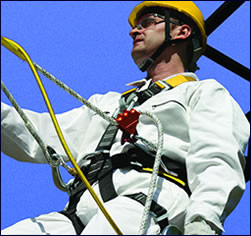Fall arrest systems save lives – here’s how

Beyond Regulations
Naturally, there are regulations that keep working at height reasonably safe through the use of harnesses, lanyards and the like. However, the regulations are there because falling from height can cause severe injury to a worker. If one's footing or grip fails while doing work on a crane, during construction or while working on any elevated platform, fall arrest systems are generally the only line of defense against a potentially life ending and almost always career ending injury. Regulations, like safety equipment in general, exist to protect people, and effective fall prevention equipment deals directly with this protection instead of mere adherence to regulations.
When dealing with a reputable supplier of fall arrest systems and related equipment, it is important to remember that their focus should not simply be on maintaining regulation standards. Their focus should be on protecting people from preventable injury due to on the job requirements.
Climbing Without Undue Fear
Climbing onto any high structure requires some kind of support. Even the world's best mountain climbers use support, and their climbing is recreational. In cases where fall arrest equipment should be used, the basic equipment is karabiners, fall arrest and work support lanyards and safety harnesses. To ensure that the worker can focus on the tasks to be performed and not on the potential for falling, this equipment should be regularly inspected to ensure that it will support more than the maximum weight of the individual plus the added force of the fall. Any equipment that does not meet these standards should be replaced at once.
It is important to keep in mind that the energy of the fall itself should always be considered in addition to the weight of the person being supported. Since force is mass times acceleration, a reasonably large 100 kg individual falling 1 metre would produce 980 joules of force against the support mechanism -- obviously more than 10 times the static force of their weight merely leaning against the mechanism. In cases where a great range of mobility is necessary, this is a reasonable amount of force to account for with any safety equipment used.
Keeping Inertia From Becoming Deadly
Inertial forces can be extremely dangerous when a fall goes out of control. This is the reason why bungee cords stretch like a rubber band instead of snapping taut like a rope. The force of the fall is a constant unless it is dissipated, which fall arrest equipment must account for. If the fall's force is merely redistributed into the pull of a line, that line could be as dangerous as the ground.
Literal Life Lines
The force of gravity pulling a worker toward the ground is not the only potential danger of falling. Particularly high in the air, wind shear can be devastating if it throws a worker against a solid object. Because of this added danger, horizontal safety lines can be as important to preventing a potentially deadly accident as vertical safety lines are.
There is a lot to consider where it concerns safety equipment. Falls are serious business, and preventing them is crucial for a responsible employer. Equipment considerations, particularly as they regard safety, are to be made with care.